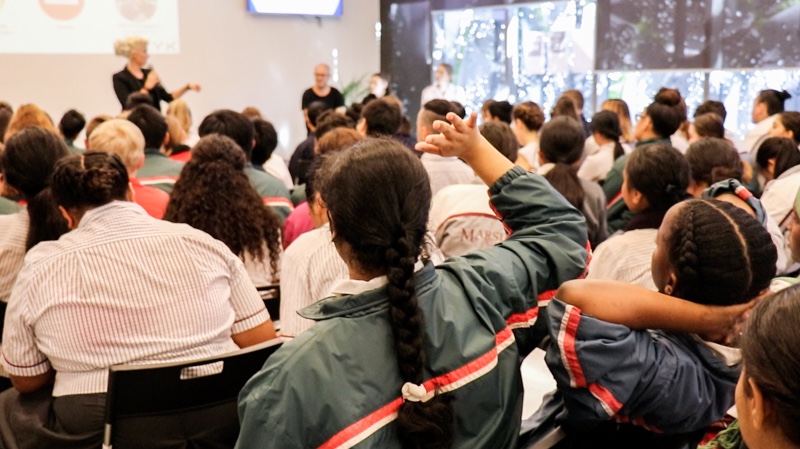
Ye old adage, ‘Don’t smile before Easter’.
Teachers, I want you to think back to the last time you had a new Principal.
I want you to think about the very first time you met them; maybe the first time that they addressed the whole staff.
I want you to consider how long it took you to decide if they were your kind of Principal or… not.
Science says we make judgements in milliseconds.
I’m not saying that you may not have had your mind changed (for better or worse) in subsequent interactions, but those first few minutes of engagement set the expectation. They prompt us to ask and answer the question; can I trust you?
Around the country, 3,948,811 young people (or thereabouts) will soon walk into new classrooms in varying states of enthusiasm about the year ahead.
Within moments of meeting a new teacher, these young people will ask the same question of their educators.
Can I trust you?
Whilst personality traits and a preceding reputation will feed this decision making moment, much of a collective class response can be curated by the purposeful and deliberate learning architecture of that first lesson.
In the majority of first lessons, the teachers will stand at the front of the room. It’s likely there will be a seating plan in place. The lesson will start with the teacher introducing themselves, and perhaps, in an awkward attempt to be inclusive, students will be asked to do the same as the roll is read out. There might even be time for an ice-breaker activity. Then, the teacher will methodically set expectations of the class environment (maybe having students copy some key rules or expectations from the board into the front of their notebook) before they then spend the remainder of the lesson going over the unit overview, upcoming assessment, and key terms.
Thrilling stuff, right?
What if we did it differently?
Years ago, I was teaching a Year 9 English class and was struggling to just… get along with a particular student. Every interaction seemed to escalate and I had become (insert other choice word/s) frustrated.
Seeking advice from a mentor, I was challenged to go and find the student during one break every day for the next fortnight and have a conversation about anything but school for at least 3 minutes but no more than 5 minutes.
I have to admit, at the time, I could think of nothing worse. It felt like a punishment.
The first time I bumped into the student we were both en route to the Tuckshop. I led with the highly inventive first question of, “What did you get up to on the weekend?” He mentioned he’d played a game of AFL on the weekend for his local club.
I confided in him that my father was a raging Collingwood fan. In fact, I said, my father’s greatest disappointment is that I support Hawthorn. In fact, those exact words were how he opened his speech on my 21st.
Thanks, Dad.
The next day, the student mentioned that he had a part-time job at the local KFC. I mentioned that my first job was at Pizza Hut. At 14, I was on an astounding $4.20/hr- something about ‘trainee’ rates. He joked that he’d never work for that.
I joked that, once you add up the hours outside of school time, he shouldn’t become a teacher.
As I gave a little more of myself, he gave away a little of the animosity he held for me. It wasn’t perfect, but it was better.
The reality is, the relationship and rapport you build with the young people in your class will have a far greater effect size on the ‘outcomes’ of your students, than anything else you say or do.
Thus, the architecture of our lessons (especially the first lesson) needs to reflect this.
We need to move away from ‘introducing’ ourselves and move closer to understanding ourselves and each other.
From understanding, we can then move to appreciating.
In this way, I often kick off my first lessons with this Learning + Me Template.
Whilst the first two quadrants provide an opportunity for teachers to understand the young person, the final two quadrants provide an opportunity to understand the learner.
Quadrant 1 + 2: The Young Person
1: I like to start from a strengths-based approach and each do the Via Character Survey (Youth)– making sure to save our results. There are a few activities you can use to introduce the survey to your class here.
2: Take the time to complete the three prompts in this quadrant. Upon completing, you could ask students to move around the room and find someone else who loves (or dislikes) the same thing they do, or shares a bucket list item. These little facts become great conversation starters with students.
Quadrant 3 + 4: The Learner
We can learn a lot about the learning environments our students thrive in by simply asking them what they like, and what they need. For many students, this might be the first time they’ve considered this. However, these two questions can be a paramount provocation to not only a young person’s engagement in classroom learning but lifelong learning.
I know the curriculum is crowded. I know you’re going to lose lessons to class photos, swimming carnivals, tech checks, and miscellaneous assemblies, but the first lesson is a little like a first date; we often see more than enough to know exactly how this is going to play out.
So, like any good first date, ask more questions than you answer. And, listen.
Want to know more about how to build the entrepreneurial mindset of young people in your classrooms? Be sure to subscribe to Future Anything’s regular e-newsletter to have resources delivered right to your inbox. You can sign up here.
As a teacher in the USA, UK and Australia as well as a Head of Department and Head of Year at some of Queensland’s top-performing public schools, Nicole has repeatedly led the design and implementation of whole-school changes to support future ready learning; placing young people at the forefront of co-designing contextually relevant learning experiences.
Nicole is an engaging and skilled facilitator, panelist and speaker who is a passionate advocate for equity, the future of education, and empowering young people to bend the future; one youth-led idea at a time.
Connect with Nic on LinkedIn here or Twitter here





